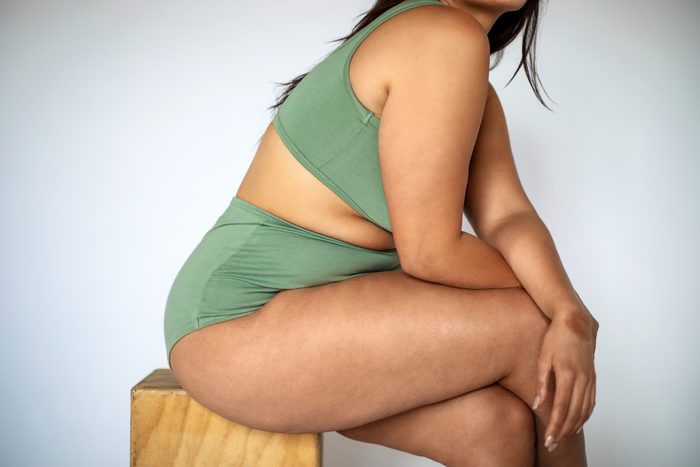What Are Yeast Infection Sores? They Exist—A Doctor Explains
Updated: Aug. 07, 2023

Think yeast infections are all about itching? As if it could get less pleasant, yeast infection sores are a thing, too. Here's what female doctors say you should look for...and how to get rid of them.
The basics on yeast infections
Yeast infections are a pretty common fungal infection that anyone can get, but you may not know that they can cause sores. Candida fungus is naturally present in our bodies, but an imbalance of it can cause an overgrowth that leads to infection and irritation, as Meleen Chuang, MD, a clinical associate professor of obstetrics and gynecology at NYU Grossman School of Medicine, tells The Healthy @Reader’s Digest.
We’re used to correlating yeast infections with women’s health—as in, vaginal yeast infections. But, says Laura Purdy, MD, a family doctor based in Nashville, TN, anyone could develop yeast infection sores or symptoms. This includes men.
Yeast infections can also can show symptoms in your mouth or on your skin due to factors like a weak immune system or diabetes, hormonal shifts and antibiotic use. Also, a lack of personal hygiene can cause a yeast infection, Dr. Chuang says.
Get The Healthy @Reader’s Digest newsletter
Yeast infection sores? Here’s the deal
Yeast infection sores may be an unexpected symptom of a yeast infection. It’s not news to say that yeast infections typically cause intense itching and irritation of the affected area. This is precisely what can develop into yeast infection sores. “The scratching or rubbing can cause the irritated skin to break down and cause worse symptoms,” Dr. Chuang adds.
Dr. Purdy says deciphering whether or not an outbreak is caused by yeast infection can be challenging. “Certain signs can help make identification simpler: Redness, swelling and itching in the affected area are typical indicators that you have an infection.” She adds that yeast infection sores “may also manifest themselves in small raised bumps called ‘pustules’ with white cottage cheese-like discharge that should prompt medical advice to diagnose and treat accordingly.”
Yeast infection sores are typically red and irritated. “There are small satellite bumps of red lesions near a large red lesion,” Dr. Chuang explains. “It could be symmetric if there is a folded skin area, often the redness and irritation is very symmetric as the yeast affect both skin areas touching,” she adds. “The location of the sore can provide clues to its cause.”
The doctors say symptoms can mimic some sexually transmitted infections, so an accurate diagnosis is key—according to Dr. Chuang: “It is important to see your medical provider or OBGYN to make sure you get the diagnosis right.”
Vaginal Odor: What’s Normal and What’s Not
Natural remedies to treat yeast infection sores, according to a leading gynecologist
Good news: The same treatments that treat a yeast infection can help with yeast infection sores, says Dr. Chuang: “Treatment typically involves antifungal medications, either over the counter or prescription, depending on how severe the infection is.”
This gynecology expert adds that there are some home remedies for yeast infections. One yeast infection treatment she recommends is to apply tea tree oil around the skin folds. A+D Ointment can also form a barrier between the skin and decrease the surface area for the skin to degrade.
Also, increase your intake of Lactobacillus, a species of bacteria usually found in plain dairy yogurt. In fact, one of Dr. Chuang’s yeast infection treatments might seem off-the-wall, but if you know, you know: A bad infection can cause such discomfort that anything is worth a try. She suggests you freeze plain yogurt in a rubber glove, then break one of the “fingers” off, squeeze it out of the glove, and insert it into the vagina at night to ease the irritation. Consider wearing a pad.
One additional note? For this yeast infection treatment, avoid using yogurt with sugar. Also eliminate sugar from your diet—it’s widely considered to be the worst food for yeast infections.
“Symptoms typically start improving within days with appropriate treatment and completely disappear within one or two weeks,” Dr. Purdy says, adding: “At-home remedies can provide temporary relief of yeast infections; however, their efficacy varies, and healthcare professional advice should always be sought to properly diagnose and treat.”
- The 5 Health Benefits of Rollerblading You Probably Didn’t Know
- I Drank Hard Seltzers Every Day for a Week—Here’s What Happened
- ‘What’s Gaby Cookin?’ Lots—Blogger Gaby Dalkin Dishes on a New Cookbook…and the Secret That Got Her Through 6 Miscarriages
- Heart Attacks Might Be Preventable with This Chinese Medicine Exercise, Says TikTok—So Does It Work?



















